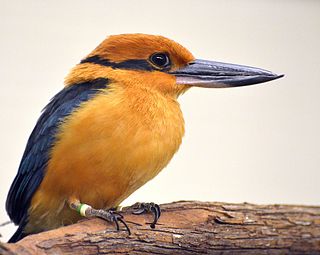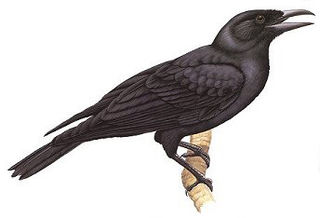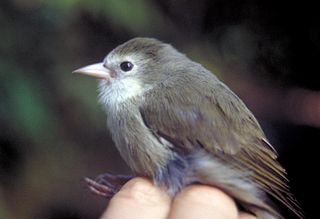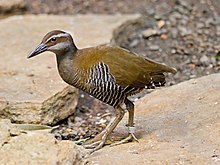
Rails are a large, cosmopolitan family of small- to medium-sized terrestrial and/or semi-amphibious birds. The family exhibits considerable diversity in its forms, and includes such ubiquitous species as the crakes, coots, and gallinule; other rail species are extremely rare or endangered. Many are associated with wetland habitats, some being semi-aquatic like waterfowl, but many more are wading birds or shorebirds. The ideal rail habitats are marsh areas, including rice paddies, and flooded fields or open forest. They are especially fond of dense vegetation for nesting. The rail family is found in every terrestrial habitat with the exception of dry desert, polar or freezing regions, and alpine areas. Members of Rallidae occur on every continent except Antarctica. Numerous unique island species are known.

The Hawaiian crow or ʻalalā is a species of bird in the crow family, Corvidae, that is currently extinct in the wild, though reintroduction programs are underway. It is about the size of the carrion crow at 48–50 cm (19–20 in) in length, but with more rounded wings and a much thicker bill. It has soft, brownish-black plumage and long, bristly throat feathers; the feet, legs, and bill are black. Today, the Hawaiian crow is considered the most endangered of the family Corvidae. They are recorded to have lived up to 18 years in the wild, and 28 years in captivity. Some Native Hawaiians consider the Hawaiian crow an ʻaumakua.

The Socorro dove or Grayson's dove is a dove that is extinct in the wild. It was endemic to Socorro Island in the Revillagigedo Islands off the west coast of Mexico. The last sighting in its natural habitat was in 1972 and it only survives in captivity. A reintroduction program is being prepared.

The Lord Howe woodhen also known as the Lord Howe Island woodhen or Lord Howe (Island) rail, is a flightless bird of the rail family, (Rallidae). It is endemic to Lord Howe Island off the Australian coast. It is currently classified as endangered by the IUCN.

The eastern barred bandicoot is a nocturnal, rabbit-sized marsupial endemic to southeastern Australia, being native to the island of Tasmania and mainland Victoria. It is one of three surviving bandicoot species in the genus Perameles. It is distinguishable from its partially-sympatric congener – the long-nosed bandicoot – via three or four dark horizontal bars found on its rump. In Tasmania, it is relatively abundant. The mainland population in Victoria is struggling and is subject to ongoing conservation endeavors.

The pink pigeon is a species of pigeon in the family Columbidae endemic to Mauritius. The pink pigeon nearly became extinct in the 1970s and the 1990s and is still very rare. It is the only Mascarene pigeon that has not become extinct. It was on the brink of extinction in 1991 when only 10 individuals remained, but its numbers have increased due to the efforts of the Durrell Wildlife Conservation Trust since 1977. While the population remains at below 500 birds as of 2011, the IUCN downlisted the species from Critically endangered to Endangered on the IUCN Red List in 2000, and then downlisted it again to Vulnerable in 2018.

Captive breeding, also known as captive propagation, is the process of keeping plants or animals in controlled environments, such as wildlife reserves, zoos, botanic gardens, and other conservation facilities. It is sometimes employed to help species that are being threatened by the effects of human activities such as climate change, habitat loss, fragmentation, overhunting or fishing, pollution, predation, disease, and parasitism.

Western Shield, managed by Western Australia's Department of Parks and Wildlife, is a nature conservation program safeguarding Western Australia's animals and protecting them from extinction. The program was set up in 1996 and as of 2009 was the largest and most successful wildlife conservation program ever undertaken in Australia.

Gallirallus is a genus of rails that live in the Australasian-Pacific region. The genus is characterised by an ability to colonise relatively small and isolated islands and thereafter to evolve flightless forms, many of which became extinct following Polynesian settlement.

The Mariana fruit dove or Marianas fruit dove, totot on Guam or Paluman totut in Northern Marianas Islands, also known as mwee’mwe in the Carolinian language, is a small, up to 24 cm long, green fruit dove native and endemic to Guam and the Northern Marianas Islands in the Pacific. It has a red forehead; greyish head, back and breast; and yellow belly patch and undertail coverts.

The Mauritius kestrel is a bird of prey from the family Falconidae endemic to the forests of Mauritius, where it is restricted to the southwestern plateau's forests, cliffs, and ravines. It is the most distinct of the Indian Ocean kestrels. It colonized its island home to evolve into a distinct species probably during the Gelasian . It is the most distant living species among the western Indian Ocean kestrels.

The Guam kingfisher is a species of kingfisher from the United States Territory of Guam. It is restricted to a captive breeding program following its extinction in the wild due primarily to predation by the introduced brown tree snake.

The Mariana crow is a species of the crow family from the tropical Western Pacific. It is a glossy black bird about 15 inches (38 cm) long and known only from the islands of Guam and Rota.

Bird conservation is a field in the science of conservation biology related to threatened birds. Humans have had a profound effect on many bird species. Over one hundred species have gone extinct in historical times, although the most dramatic human-caused extinctions occurred in the Pacific Ocean as humans colonised the islands of Melanesia, Polynesia and Micronesia, during which an estimated 750–1,800 species of birds became extinct. According to Worldwatch Institute, many bird populations are currently declining worldwide, with 1,200 species facing extinction in the next century. The biggest cited reason surrounds habitat loss. Other threats include overhunting, accidental mortality due to structural collisions, long-line fishing bycatch, pollution, competition and predation by pet cats, oil spills and pesticide use and climate change. Governments, along with numerous conservation charities, work to protect birds in various ways, including legislation, preserving and restoring bird habitat, and establishing captive populations for reintroductions.

The ʻakikiki, also called the Kauaʻi creeper, is a critically endangered Hawaiian honeycreeper endemic to Kauaʻi, Hawaiʻi. It is the only member of the genus Oreomystis. Of the Hawaiian birds known to be extant, it is thought to be the most endangered, with only 454 wild individuals known as of 2018. A survey report in 2021 estimated the population at 45 with a 5 percent annual decrease, and in July 2023 the remaining number of wild birds was estimated to be just 5 individuals. This species is predicted to be extinct in the wild in 2023.

The bridled white-eye is a species of white-eye native to the Mariana Islands and formerly Guam. The species' natural habitat is tropical forests, shrublands and urban areas.
Robert E. Beck Jr. was a zoologist and conservationist, who worked to save Guam's indigenous native birds from 1982 to 2003. Beck championed the fight to save Guam's native birds, such as the Mariana crow, rufous fantail, Guam flycatcher, Guam kingfisher and the Guam rail, known locally as ko'ko' in Chamorro, which are under the extreme threat of extinction due to the non-native brown tree snake and habitat loss. The rufous fantail and the Guam flycatcher listed above are now extinct in the wild in their native Guam. However, the captive and wild populations of the Mariana crow, Guam rail and the Micronesian kingfisher have increased, due in large part to conservation efforts by Beck.

Leptodactylus fallax, commonly known as the mountain chicken or giant ditch frog, is a critically endangered species of frog that is native to the Caribbean islands of Dominica and Montserrat. The population declined by at least 80% from 1995 to 2004, with further significant declines later. A tiny wild population remains on Dominica where there are efforts to preserve it, but few or none survive in the wild on Montserrat and its survival now relies on a captive breeding project involving several zoos. The initial decline was linked to hunting for human consumption, along with habitat loss and natural disasters, but the most serious threat now appears to be the fungal disease chytridiomycosis, which was the primary cause of the most recent rapid decline. On Montserrat it is known as the mountain chicken, while on Dominica it is known as the crapaud.
Conservation-induced extinction is where efforts to save endangered species lead to the extinction of other species. This mostly threatens the parasite and pathogen species that are highly host-specific to critically endangered hosts. When the last individuals of a host species are captured for the purpose of captive breeding and reintroduction programs, they typically undergo anti-parasitic treatments to increase survival and reproductive success. This practice may unintentionally result in the extinction of the species antagonistic to the target species, such as certain parasites. It has been proposed that the parasites should be reintroduced to the endangered population. A few cases of conservation-induced extinction have occurred in parasitic lice.
As with a number of other geographically isolated islands, Guam has problems with invasive species negatively affecting the natural biodiversity of the island.



















